Deer hunting is much more than just having a good shot. Even great shots can result in the deer running away deeper into the woods and you’ve got to track it in order to recover the body. That’s where the blood trail comes in. The color of a deer’s blood can also tell you how long you should wait before attempting to trail and recover the deer’s body. Keep reading to find out more information on explaining deer blood color, including our useful deer blood color chart.
Learn more about how the color of the blood trail provides information on shot placement and how long you should wait to follow the blood trail in this essential guide.
How Can Blood Tell You Where You Hit a Deer?
Immediately dropping a deer with one shot is a relatively rare feat.
When blood-trailing deer, the color of the blood trail can tell you which part of the deer’s body you hit.
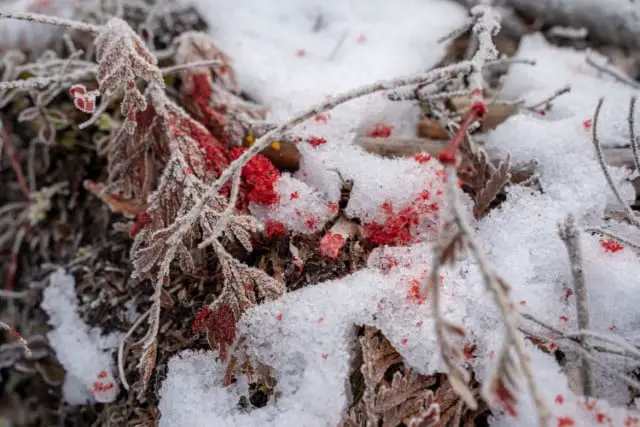
Is the blood bright red? That means you’ve landed a fatal shot.
A darker blood color, on the other hand, means you’ve hit a digestive organ.
The trail pattern and the amount of blood splatter can also reveal many things. If you see small, round droplets of blood with little splatter, it could mean that the wounded deer is still walking but limping.
Meanwhile, irregular blood splatters could mean that the deer has stopped, laid down, or is close to collapsing.
Usually, a deer shot in the heart leaves fist-size blood splatters, while a pass-through shot in the lungs generally appears as sprays of blood.
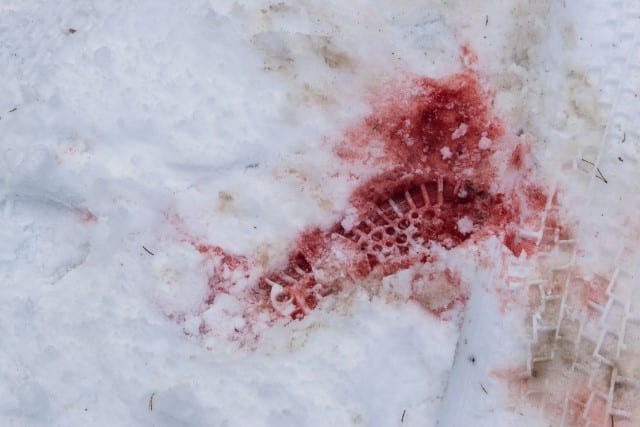
Besides looking at the ground for blood trails, you should also pay close attention to the shrubs and other foliage in the area. Sometimes, blood won’t have started dripping on the ground, and the deer’s wound will just brush against leaves and tree trunks.
That’s why you should look for blood there, too.
What Does Bright Red Blood from a Deer Mean?
A trail of bright red blood could mean you’ve hit deer in either the heart or the lungs. Frothy blood or blood with small bubbles probably means you’ve hit the deer’s lungs.
In these circumstances, you’ll likely find your deer within 100 to 150 yards from where you shot it.
Blood from a heart shot is dark or crimson red. You’ll likely see large amounts of blood on the ground, shrubs, and tree trunks, as the heart pumps out blood, causing it to spurt from the wound.
A deer shot in the heart can usually only run fewer than 150 yards when where it was hit. Refer to the deer blood color chart we go over later for more information.
What Does Dark Red Blood Mean When Tracking a Deer?
A deer that leaves a thick, dark red, or purplish blood trail could mean that your shot landed in its liver.
Compared to the blood splatter from a heart shot, the blood trail coming from a liver shot would appear as droplets instead of spurts because of the lack of blood pressure.
What Color Is Liver Blood on a Deer?
If you hit a deer in the liver, you would see dark or crimson red blood. The blood usually has a thick consistency, but the blood splatter could be very little that you need to wait about four hours before you track the deer.
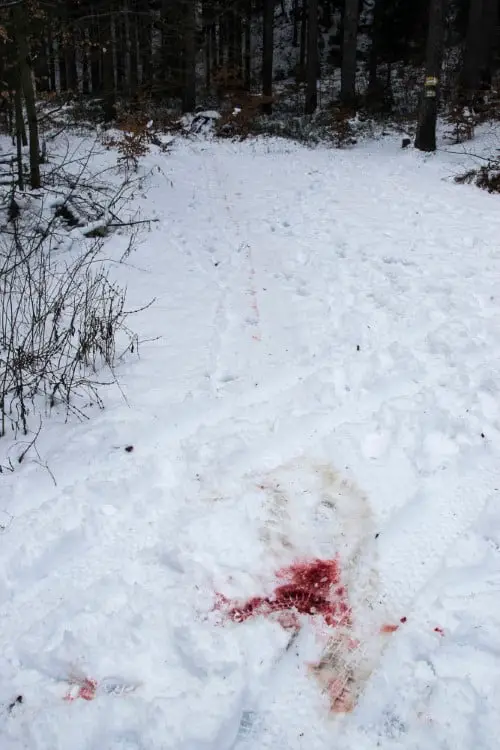
Gut Shot Deer Blood Color
If the blood trail is brownish-red, it could be a gut or paunch shot or a hit on the deer’s stomach or intestines.
The blood from a gut shot may also come with a green or brown tint, which is likely the contents of the deer’s digestive tract. It may give off a foul smell because of the stomach matter or bowel contents.
Deer Muscle Blood Color
Like a liver shot, a muscle shot produces a red blood trail. But the latter has a soupy or watery consistency.
The deer will leave only moderate amounts of blood at first, but when the blood clots, the trail could stop. Recovery will be more difficult in this case.
Deer Blood Color Chart
The deer blood color chart below shows the color of blood and waiting times based on the deer’s body part that you’ve hit.
| Body Part | Blood Color | Blood Trail Appearance | How Long Should You Wait to Trail the Deer? |
|---|---|---|---|
| Heart | Dark Red | Large, fist-size spurts on the ground, shrubs, and tree trunks | Immediately if you see the animal stop and fall, or at least 30 minutes if it runs away |
| Lungs | Bright Red | Droplets instead of sprays of blood; blood has a frothy consistency or small bubbles | Same as a heart shot |
| Liver | Dark Red or purplish | Little splatter or droplets because there’s not much pressure to pump out blood | At least four hours |
| Gut (Stomach or Intestines) | Red | Often comes with a tinge of green or yellow (stomach matter and bowel contents) and a repulsive odor | At least eight hours |
| Muscle | Red | Watery consistency; large splatters at first, then stops as blood starts clotting | Immediately if you’re sure it’s a muscle shot |
Tips for Following a Deer Blood Trail
Nothing beats the pride and sense of accomplishment that accompanies hitting your target. But you shouldn’t go tracking the deer immediately unless you’re sure you landed a fatal shot.
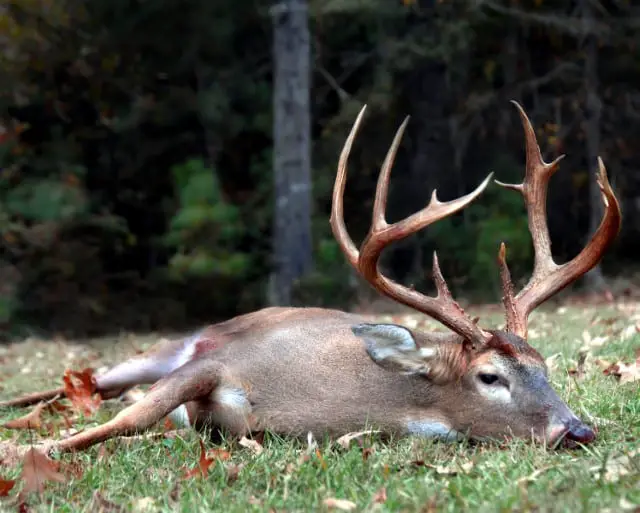
Blood-trailing tactics differ based on the deer’s body part that you’ve shot. Here are some tips for following a deer’s blood trail to help increase the recovery success rate.
Heart Shot
You’ll know that you’ve landed a fatal shot to the heart when the deer kicks out its hind legs and darts off with its tail down.
The impact of the bullet or arrow feels like an electric shock, which prompts the deer to run away from the spot, typically in the direction that it is facing.
Deer can run from 15 to less than a hundred yards away before it expires. However, they could also run as far as 300 yards away if the hunting ground has a little cover.
A heart shot usually makes a quick kill. However, you should wait for about 30 minutes to an hour before trailing, unless you see the deer collapse on the ground and it no longer moves.
Lung Shot
Just like when they’re shot in the heart, a deer will hastily flee from where it is standing if it gets shot in the lungs. Massive bleeding usually results if the bullet or arrow pierces through both lungs and damages arteries.
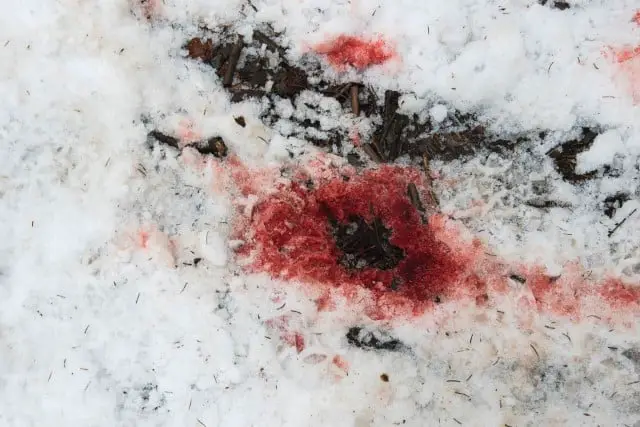
The deer may run fast at first but slow down when it loses too much blood. It won’t go very far and may collapse within about 200 yards from its original position.
Ideally, you should wait for 30 minutes to one hour before trailing the deer.
If you get a single lung shot, the deer could live longer before it expires. In this case, you should wait between four and six hours before you start blood-trailing.
Liver Shot
If you’re aiming for the heart or the lungs and miss, the organ you’re most likely hit is the liver, which is located between the lungs and stomach. It is also a fatal shot, especially if arteries are damaged by the hit.
Waiting time is typically at least four hours before you trail the deer. It will bed down not farther than a couple of hundred yards and expire in that location.
Gut Shot
A gut shot is considered one of the most dreaded shots in deer hunting. Not only does it have a long waiting time before trailing, a gut shot often leaves a putrid stench. That is because the blood trails are accompanied by food matter.
A gut shot deer will leave little blood on the trail due to the lack of arterial pressure.
If you think that you’ve hit the deer in the guts, you might need to make a second shot. If you don’t get a second shot, you should wait for at least eight hours before you start trailing the deer.
The deer will either walk or run as far as a hundred yards and look for a place to bed down. It will then die of septic shock or organ failure.
Muscle Shot
Blood from a muscle is bright red, so it’s easy to confuse with a lung or heart shot.
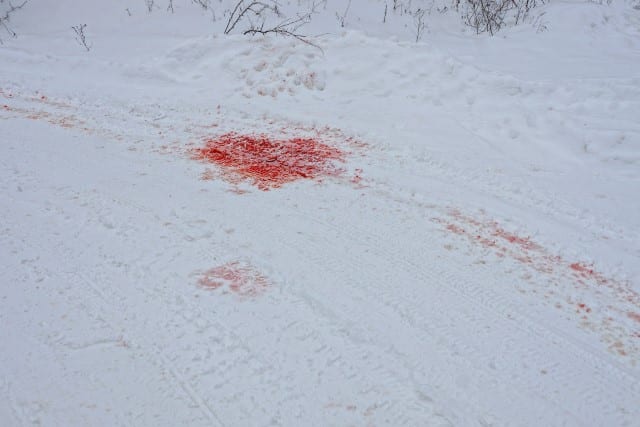
A muscle shot usually results in heavy droplets within the first few yards from the place of impact. This is followed by thinner droplets as the blood begins to clot.
Pursuing a muscle-shot deer can be difficult because as soon as the blood clots, you may not have enough blood trail to follow.
More Tips for Blood Trailing Deer
Here’s our list of essential tips for blood-trailing deer.
Watch Where You Shoot
Whenever you take a shot, make sure you focus on the spot the arrow or bullet hits. It could be challenging, but knowing where your shot lands can help you decide whether you need to make a second shot and when to start blood-trailing.
Know Where You Are
Remember the spot where the deer was standing when you hit it. Doing this helps you calculate the distance the deer could travel and where to start trailing.

Observe the Deer’s Reaction
Observe the deer’s reaction upon impact. For example, a high kick before running off could mean a heart shot, or a deer that runs for a few yards then stops, and hunches could mean it was shot in the stomach.
Mark the Spot
Mark the spot you’re trailing with tape, bright cloth, or anything easy to see, so you won’t end up following the same area.
Find a New Path to the Trail
If the trail suddenly stops, go back to the spot where you last saw blood. Then, search for traces of blood to the left and right side of the trail you were originally following.
Look for Nearby Bodies of Water
If there’s a body of water nearby, consider searching there, especially if you suspect you hit a deer in the stomach.
Look for Areas With Thick Cover
Wounded deer often take the path where there is thick cover or least resistance, so consider searching for blood trails on sloping hills or thickets.
Keep An Eye Out for Scavengers
Keep an eye out for scavengers, as they may provide clues on where the deer has bedded down.
How Long Will a Deer Blood Trail Last?
Tempting as it may be, pursuing deer immediately after hitting it is not the best option unless it drops dead in its tracks. The time it takes before the deer dies after getting hit varies.
That’s why it is important to wait before you start trailing.
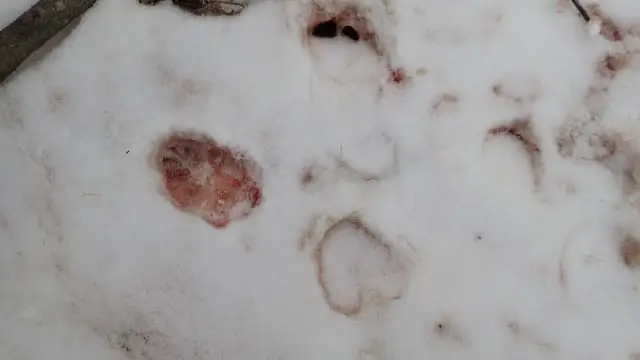
However, waiting could have some disadvantages. Other predators and scavengers might find the wounded or expired deer before you do.
Heavy rains or snowfall can wash away the blood and make recovery more difficult.
Blood-trailing at night could be unsafe, especially if there are other wild animals around or if the temperature drops.
If the shot is not fatal or only nicks the deer and a follow-up shot is needed, blood clotting can occur quickly, which can end the trail of blood.
Another downside of waiting before blood trailing is that the blood trail can dry after about four hours if the weather is dry. The blood can stay wet longer in areas where there is dew on the ground.
Yes, you might worry that the blood trail won’t last long enough to wait the right amount of time for trailing. However, seasoned deer hunters advise following the waiting times for successful recovery process.
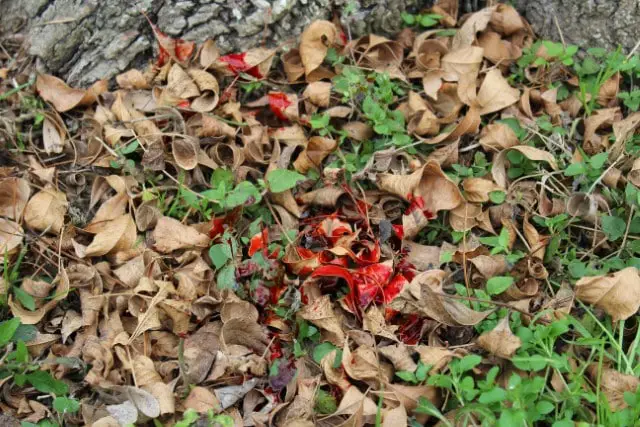
If you’re ever unable to find any more blood on the trail you’re following, you can try other methods. For example, you can use drones and tracking dogs (as long as these methods aren’t against local laws).
There are other clues you can look for in your surroundings too, such as drag marks, broken twigs, and deer hair/fur on shrubs and branches.
Final Thoughts On Explaining Deer Blood Color
Many new deer hunters are surprised that deer blood trails have a different color depending on shot positioning. In other words, it depends on where the bullet penetrates and ends up in the deer’s body.
How long you need to wait before you trail the deer to recover the carcass depends on where you’ve shot it, and therefore on the blood color.
That’s why you can refer to our deer blood color chart for a quick and easy reference when deciding how long to wait before following the blood trail to recover your deer.


